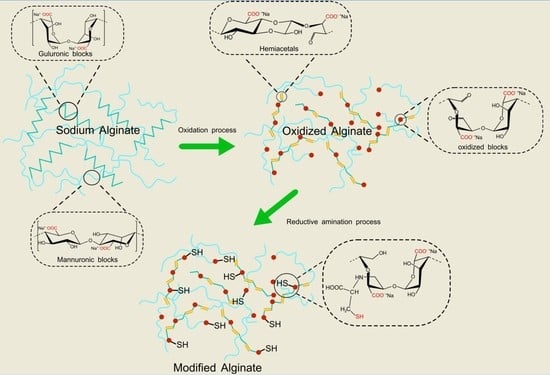Functionalization of an Alginate-Based Material by Oxidation and Reductive Amination
Abstract
1. Introduction
2. Materials and Methods
2.1. Materials
2.2. Purification of Commercial Alginate
2.3. Functionalization of Purified Alginate with Cysteine
3. Characterization
3.1. Evaluation of Polyphenols by UV-Vis
3.2. Evaluation of Thiols by UV-Vis
3.3. FT-IR Measurements
3.4. 1H NMR and HSQC Analyses of AlgP
3.5. Analysis of Alginate Derivatives by Solid State 13C NMR
4. Results and Discussion
4.1. Analysis of the Starting Material
4.2. Evaluation of Alginate Functionalization
4.2.1. FT-IR spectroscopy
4.2.2. Analysis of Alginate and Its Derivatives by 13C NMR in Solid State
5. Conclusions
Supplementary Materials
Author Contributions
Funding
Institutional Review Board Statement
Informed Consent Statement
Data Availability Statement
Acknowledgments
Conflicts of Interest
References
- Hernandez-Carmona, G.; Mchugh, D.J.; Arvizu-higuera, D.L.; Rodriguez, E. Pilot plant scale extraction of alginate from Macrocystis pyrifera. 1. Effect of pre-extraction treatments on yield and quality of alginate. Environ. Boil. Fishes 1999, 10, 507–513. [Google Scholar]
- Acleto, C. The seaweed resources of Peru. In Seaweed Resources of the World; Critchley, A.T., Ohno, M., Eds.; Japan International Cooperation Agency: Tokyo, Japan, 1998; p. 431. [Google Scholar]
- Tiwari, B.K.; Troy, D.J. Seaweed Sustainability: Food and Non-Food Applications; Academic Press: Cambridge, MA, USA, 2015; ISBN 9780124199583. [Google Scholar]
- Hernández-Carmona, G.; Freile-Pelegrín, Y.; Hernández-Garibay, E. Conventional and Alternative Technologies for the Extraction of Algal Polysaccharides; Woodhead Publishing: Sawston, UK, 2013; pp. 475–516. ISBN 9780857095121. [Google Scholar]
- Indergaard, M.; Skjåk-Bræk, G. Characteristics of alginate from Laminaria digitata cultivated in a high-phosphate environment. Hydrobiologia 1987, 151–152, 541–549. [Google Scholar] [CrossRef]
- Wijesekara, I.; Kim, S.K.; Li, Y. Phlorotannins as bioactive agents from brown algae. Process Biochem. 2011, 46, 2219–2224. [Google Scholar] [CrossRef]
- Matsuhiro, B. Characterization of a fucoidan from Lessonia vadosa (Phaeophyta) and its anticoagulant and elicitor properties. Int. J. Biol. Macromol. 2008, 42, 235–240. [Google Scholar]
- Lee, K.Y.; Mooney, D.J. Alginate: Properties and biomedical applications. Prog. Polym. Sci. 2012, 37, 106–126. [Google Scholar] [CrossRef] [PubMed]
- Draget, K.I.; Taylor, C. Chemical, physical and biological properties of alginates and their biomedical implications. Food Hydrocoll. 2011, 25, 251–256. [Google Scholar] [CrossRef]
- Mazumder, A.; Holdt, S.L.; De Francisci, D.; Alvarado-Morales, M.; Mishra, H.N.; Angelidaki, I. Extraction of alginate from Sargassum muticum: Process optimization and study of its functional activities. J. Appl. Phycol. 2016, 28, 3625–3634. [Google Scholar] [CrossRef]
- Rhein-Knudsen, N.; Ale, M.T.; Ajalloueian, F.; Meyer, A.S. Characterization of alginates from Ghanaian brown seaweeds: Sargassum spp. and Padina spp. Food Hydrocoll. 2017, 71, 236–244. [Google Scholar] [CrossRef]
- Valeur, M.; Markussen, S.; Ellingsen, T.E.; Skjåk-bræk, G. Influence of environmental conditions on the activity of the recombinant mannuronan C-5-epimerase AlgE2. Enzym. Microb. Technol. 2001, 28, 57–69. [Google Scholar]
- Tøndervik, A.; Klinkenberg, G.; Aachmann, F.L.; Svanem, B.I.G.; Ertesvaìšg, H.; Ellingsen, T.E.; Valla, S.; Skjaìšk-Bræk, G.; Sletta, H. Mannuronan C-5 epimerases suited for tailoring of specific alginate structures obtained by high-throughput screening of an epimerase mutant library. Biomacromolecules 2013, 14, 2657–2666. [Google Scholar] [CrossRef]
- Ilmi, Z.N.; Wulandari, P.A.C.; Husen, S.A.; Winarni, D.; Alamsjah, M.A.; Awang, K.; Vastano, M.; Pellis, A.; Macquarrie, D.; Pudjiastuti, P. Characterization of alginate from sargassum duplicatum and the antioxidant effect of alginate-okra fruit extracts combination for wound healing on diabetic mice. Appl. Sci. 2020, 10, 6082. [Google Scholar] [CrossRef]
- Keil, C.; Hübner, C.; Richter, C.; Lier, S.; Barthel, L.; Meyer, V.; Subrahmanyam, R.; Gurikov, P.; Smirnova, I.; Haase, H. Ca-Zn-Ag Alginate Aerogels for Wound Healing Applications: Swelling Behavior in Simulated Human Body Fluids and Effect on Macrophages. Polymers 2020, 12, 2741. [Google Scholar] [CrossRef] [PubMed]
- Patwa, R.; Zandraa, O.; Capáková, Z.; Saha, N.; Sáha, P. Effect of iron-oxide nanoparticles impregnated bacterial cellulose on overall properties of alginate/casein hydrogels: Potential injectable biomaterial for wound healing applications. Polymers 2020, 12, 2690. [Google Scholar] [CrossRef] [PubMed]
- Bevilacqua, A.; Campaniello, D.; Speranza, B.; Racioppo, A.; Altieri, C.; Sinigaglia, M.; Corbo, M.R. Microencapsulation of saccharomyces cerevisiae into alginate beads: A focus on functional properties of released cells. Foods 2020, 9, 1051. [Google Scholar] [CrossRef] [PubMed]
- Valente, J.F.A.; Dias, J.R.; Sousa, A.; Alves, N. Composite central face design-an approach to achieve efficient alginate microcarriers. Polymers 2019, 11, 1949. [Google Scholar] [CrossRef] [PubMed]
- Kühn, P.T.; Rozenbaum, R.T.; Perrels, E.; Sharma, P.K.; van Rijn, P. Anti-microbial biopolymer hydrogel scaffolds for stem cell encapsulation. Polymers 2017, 9, 149. [Google Scholar] [CrossRef]
- Huang, C.H.; Chuang, T.J.; Ke, C.J.; Yao, C.H. Doxorubicin-gelatin/Fe3O4-Alginate dual-layer magnetic nanoparticles as targeted anticancer drug delivery vehicles. Polymers 2020, 12, 1747. [Google Scholar] [CrossRef]
- Cheaburu-Yilmaz, C.N.; Lupuşoru, C.E.; Vasile, C. New alginate/PNIPAAm matrices for drug delivery. Polymers 2019, 11, 366. [Google Scholar] [CrossRef]
- Alnaief, M.; Obaidat, R.M.; Alsmadi, M.M. Preparation of hybrid alginate-chitosan aerogel as potential carriers for pulmonary drug delivery. Polymers 2020, 12, 2223. [Google Scholar] [CrossRef]
- Bernkop-Schnürch, A.; Greimel, A. Thiomers: The next generation of mucoadhesive polymers. Am. J. Drug Deliv. 2005, 3, 141–154. [Google Scholar] [CrossRef]
- Draget, K.I.; SkjåK-Braek, G. Alginates: Existing and potential biotechnological and medical applications. RSC Polym. Chem. Ser. 2011, 1, 186–209. [Google Scholar]
- Szabó, L.; Gerber-Lemaire, S.; Wandrey, C. Strategies to Functionalize the Anionic Biopolymer Na-Alginate without Restricting Its Polyelectrolyte Properties. Polymers 2020, 12, 919. [Google Scholar] [CrossRef]
- Martí, M.; Frígols, B.; Salesa, B.; Serrano-Aroca, Á. Calcium alginate/graphene oxide films: Reinforced composites able to prevent Staphylococcus aureus and methicillin-resistant Staphylococcus epidermidis infections with no cytotoxicity for human keratinocyte HaCaT cells. Eur. Polym. J. 2019, 110, 14–21. [Google Scholar] [CrossRef]
- Salesa, B.; Martí, M.; Frígols, B.; Serrano-Aroca, Á. Carbon nanofibers in pure form and in calcium alginate composites films: New cost-effective antibacterial biomaterials against the life-threatening multidrug-resistant Staphylococcus epidermidis. Polymers 2019, 11, 453. [Google Scholar] [CrossRef]
- Ma, X.; Li, R.; Zhao, X.; Ji, Q.; Xing, Y.; Sunarso, J.; Xia, Y. Biopolymer composite fibres composed of calcium alginate reinforced with nanocrystalline cellulose. Compos. Part A Appl. Sci. Manuf. 2017, 96, 155–163. [Google Scholar] [CrossRef]
- Córdova, B.M.; Venâncio, T.; Olivera, M.; Huamani-Palomino, R.G.; Valderrama, A.C. Xanthation of alginate for heavy metal ions removal. Characterization of xanthate-modified alginates and its metal derivatives. Int. J. Biol. Macromol. 2021, 169, 130–142. [Google Scholar] [CrossRef]
- Albrecht, K.; Bernkop-Schnürch, A. Thiomers: Forms, functions and applications to nanomedicine. Nanomedicine 2007, 2, 41–50. [Google Scholar] [CrossRef]
- Bernkop-Schnürch, A. Thiomers: A new generation of mucoadhesive polymers. Adv. Drug Deliv. Rev. 2005, 57, 1569–1582. [Google Scholar] [CrossRef]
- Huamani-Palomino, R.G.; Jacinto, C.R.; Alarcón, H.; Mejía, I.M.; López, R.C.; de Silva, D.O.; Cavalheiro, E.T.G.; Venâncio, T.; Dávalos, J.Z.; Valderrama, A.C. Chemical modification of alginate with cysteine and its application for the removal of Pb(II) from aqueous solutions. Int. J. Biol. Macromol. 2019, 129, 1056–1068. [Google Scholar] [CrossRef]
- Grewal, P.; Mundlia, J.; Ahuja, M. Thiol modified Moringa gum—A potential bioadhesive polymer. Carbohydr. Polym. 2019, 209, 400–408. [Google Scholar] [CrossRef]
- Puri, V.; Sharma, A.; Kumar, P.; Singh, I. Thiolation of biopolymers for developing drug delivery systems with enhanced mechanical and mucoadhesive properties: A review. Polymers 2020, 12, 1803. [Google Scholar] [CrossRef] [PubMed]
- Hintzen, F.; Hauptstein, S.; Perera, G.; Bernkop-Schnürch, A. Synthesis and in vitro characterization of entirely S-protected thiolated pectin for drug delivery. Eur. J. Pharm. Biopharm. 2013, 85, 1266–1273. [Google Scholar] [CrossRef]
- Kurniawan, D.W.; Fudholi, A.; Susidarti, R.A. Synthesis of Thiolated Chitosan as Matrix for the Preparation of Metformin Hydrochloride Microparticles. Res. Pharm. 2012, 2, 26–35. [Google Scholar]
- Madison, S.A.; Carnali, J.O. PH optimization of amidation via carbodiimides. Ind. Eng. Chem. Res. 2013, 52, 13547–13555. [Google Scholar] [CrossRef]
- Yang, Y. Side Reactions in Peptide Synthesis; Academic Press: Cambridge, MA, USA, 2015; Volume 43, pp. 1–326. ISBN 9780128011812. [Google Scholar]
- Prokopijevic, M.; Prodanovic, O.; Spasojevic, D.; Kovacevic, G.; Polovic, N.; Radotic, K.; Prodanovic, R. Tyramine-modified pectins via periodate oxidation for soybean hull peroxidase induced hydrogel formation and immobilization. Appl. Microbiol. Biotechnol. 2017, 101, 2281–2290. [Google Scholar] [CrossRef] [PubMed]
- Dalheim, M.; Vanacker, J.; Najmi, M.A.; Aachmann, F.L.; Strand, B.L.; Christensen, B.E. Efficient functionalization of alginate biomaterials. Biomaterials 2016, 80, 146–156. [Google Scholar] [CrossRef]
- Bouhadir, K.H.; Lee, K.Y.; Alsberg, E.; Damm, K.L.; Anderson, K.W.; Mooney, D.J. Degradation of partially oxidized alginate and its potential application for tissue engineering. Biotechnol. Prog. 2001, 17, 945–950. [Google Scholar] [CrossRef]
- Christensen, B.E.; Vold, I.M.N.; Vårum, K.M. Chain stiffness and extension of chitosans and periodate oxidised chitosans studied by size-exclusion chromatography combined with light scattering and viscosity detectors. Carbohydr. Polym. 2008, 74, 559–565. [Google Scholar] [CrossRef]
- Balakrishnan, B.; Lesieur, S.; Labarre, D.; Jayakrishnan, A. Periodate oxidation of sodium alginate in water and in ethanol-water mixture: A comparative study. Carbohydr. Res. 2005, 340, 1425–1429. [Google Scholar] [CrossRef]
- Hauptstein, S.; Müller, C.; Dünnhaupt, S.; Laffleur, F.; Bernkop-Schnürch, A. Preactivated thiomers: Evaluation of gastroretentive minitablets. Int. J. Pharm. 2013, 456, 473–479. [Google Scholar] [CrossRef]
- Stanisci, A.; Aarstad, O.A.; Tøndervik, A.; Sletta, H.; Dypås, L.B.; Skjåk-Bræk, G.; Aachmann, F.L. Overall size of mannuronan C5-Epimerases influences their ability to epimerize modified alginates and alginate gels. Carbohydr. Polym. 2018, 180, 256–263. [Google Scholar] [CrossRef] [PubMed]
- Draget, K.I.; Smidsrød, O.; Skjåk-Bræk, G. Alginates from Algae. In Biopolymers, Biology, Chemistry, Biotechnology, Applications; Alexander, S., Ed.; Wiley: Hoboken, NJ, USA, 2005; Volume 1, ISBN 9783527600038. [Google Scholar]
- Jain, S.; Mondal, K.; Gupta, M.N. Applications of Alginate in Bioseparation of Proteins Applications of Alginate in Bioseparation of Proteins. Artif. Cells Blood Substit. Biotechnol. 2006, 34, 127–144. [Google Scholar] [CrossRef] [PubMed]
- Usov, A.I.; Smirnova, G.P.; Kamenarska, Z.; Dimitrova-konaklieva, S. Polar Constituents of Brown Seaweed Colpomenia peregrina (Sauv.) Hamel from the Black Sea. Russ. J. Bioorganic Chem. 2004, 30, 161–167. [Google Scholar] [CrossRef] [PubMed]
- Đorović, J.; Marković, Z.; Petrović, Z.D.; Simijonović, D.; Petrović, V.P. Theoretical analysis of the experimental UV-Vis absorption spectra of some phenolic schiff bases. Mol. Phys. 2017, 115, 2460–2468. [Google Scholar] [CrossRef]
- Sathya, R.; Kanaga, N.; Sankar, P.; Jeeva, S. Antioxidant properties of phlorotannins from brown seaweed Cystoseira trinodis (Forsskål) C. Agardh. Arab. J. Chem. 2017, 10, S2608–S2614. [Google Scholar] [CrossRef]
- Antosiewicz, J.M.; Shugar, D. UV–Vis spectroscopy of tyrosine side-groups in studies of protein structure. Part 1: Basic principles and properties of tyrosine chromophore. Biophys. Rev. 2016, 8, 151–161. [Google Scholar] [CrossRef]
- Pawar, S.N.; Edgar, K.J. Alginate derivatization: A review of chemistry, properties and applications. Biomaterials 2012, 33, 3279–3305. [Google Scholar] [CrossRef]
- Salomonsen, T.; Jensen, H.M.; Larsen, F.H.; Steuernagel, S.; Engelsen, S.B. Direct quantification of M/G ratio from 13C CP-MAS NMR spectra of alginate powders by multivariate curve resolution. Carbohydr. Res. 2009, 344, 2014–2022. [Google Scholar] [CrossRef]
- Grasdalen, H. High-field, 1H-n.m.r. spectroscopy of alginate: Sequential structure and linkage conformations. Carbohydr. Res. 1983, 118, 255–260. [Google Scholar] [CrossRef]
- Penman, A.; Sanderson, G.R. A method for the determination of uronic acid sequence in alginates. Carbohydr. Res. 1972, 25, 273–282. [Google Scholar] [CrossRef]
- Khanna, O.; Moya, M.L.; Opara, E.C.; Brey, E.M. Synthesis of multilayered alginate microcapsules for the sustained release of fibroblast growth factor-1. J. Biomed. Mater. Res. Part A 2010, 95, 632–640. [Google Scholar] [CrossRef] [PubMed]
- Wang, Q.; Nielsen, U.G. Applications of solid-state NMR spectroscopy in environmental science. Solid State Nucl. Magn. Reson. 2020, 110, 101698. [Google Scholar] [CrossRef] [PubMed]
- Cardenas-Jiron, G.; Leal, D.; Matsuhiro, B.; Osorio-Roman, I.O. Vibrational spectroscopy and density functional theory calculations of poly-D-mannuronate and heteropolymeric fractions from sodium alginate. J. Raman Spectrosc. 2011, 42, 870–878. [Google Scholar] [CrossRef]
- Leal, D.; Matsuhiro, B.; Rossi, M.; Caruso, F. FT-IR spectra of alginic acid block fractions in three species of brown seaweeds. Carbohydr. Res. 2008, 343, 308–316. [Google Scholar] [CrossRef] [PubMed]
- Maddams, W.F.; Mead, W.L. The measurement of derivative i.r. spectra-I. Background studies. Spectrochim. Acta Part A Mol. Spectrosc. 1982, 38, 437–444. [Google Scholar] [CrossRef]
- Martínez-Gómez, F.; Mansilla, A.; Matsuhiro, B.; Matulewicz, M.C.; Troncoso-Valenzuela, M.A. Chiroptical characterization of homopolymeric block fractions in alginates. Carbohydr. Polym. 2016, 146, 90–101. [Google Scholar] [CrossRef]
- Martínez-Gõmez, F.; Encinas, M.V.; Matsuhiro, B.; Pavez, J. Preparation and swelling properties of homopolymeric alginic acid fractions/poly(N-isopropyl acrylamide) graft copolymers. J. Appl. Polym. Sci. 2015, 132, 1–10. [Google Scholar] [CrossRef]
- Kristiansen, K.A.; Tomren, H.B.; Christensen, B.E. Periodate oxidized alginates: Depolymerization kinetics. Carbohydr. Polym. 2011, 86, 1595–1601. [Google Scholar] [CrossRef]
- Visheratina, A.K.; Purcell-Milton, F.; Serrano-García, R.; Kuznetsova, V.A.; Orlova, A.O.; Fedorov, A.V.; Baranov, A.V.; Gun’ko, Y.K. Chiral recognition of optically active CoFe2O4 magnetic nanoparticles by CdSe/CdS quantum dots stabilised with chiral ligands. J. Mater. Chem. C 2017, 5, 1692–1698. [Google Scholar] [CrossRef]
- Larsen, B.; Painter, T.J. Preliminary communication the periodate-oxidation limit of alginate. Carbohydr. Res. 1969, 10, 186–187. [Google Scholar] [CrossRef]
- Córdova, B.M.; Jacinto, C.R.; Alarcón, H.; Mejía, I.M.; López, R.C.; de Silva, D.O.; Cavalheiro, E.; Venâncio, T.; Dávalos, J.Z.; Valderrama, A.C. Chemical modification of sodium alginate with thiosemicarbazide for the removal of Pb(II) and Cd(II) from aqueous solutions. Int. J. Biol. Macromol. 2018, 120, 2259–2270. [Google Scholar] [CrossRef] [PubMed]
- Kallen, R.G. Equilibria for the Reaction of Cysteine and Derivatives with Formaldehyde and Protons. J. Am. Chem. Soc. 1971, 93, 6227–6235. [Google Scholar] [CrossRef] [PubMed]
- Smidsrød, O.; Larsen, B.; Haug, A. Acid hydrolysis of polysaccharides containing uronic acid residues. Carbohydr. Res. 1967, 5, 371–372. [Google Scholar] [CrossRef]
- Kristiansen, K.A.; Dalheim, M.; Christensen, B.E. Periodate oxidation and macromolecular compaction of hyaluronan. Pure Appl. Chem. 2013, 85, 1893–1900. [Google Scholar] [CrossRef]
- Alinezhad, H.; Tajbakhsh, M.; Hamidi, N. Reductive amination of aldehydes and ketones using sodium borohydride in the presence of silica chloride under solvent-free conditions. Chin. Chem. Lett. 2010, 21, 47–50. [Google Scholar] [CrossRef]
- Cho, B.T.; Kang, S.K. Direct and indirect reductive amination of aldehydes and ketones with solid acid-activated sodium borohydride under solvent-free conditions. Tetrahedron 2005, 61, 5725–5734. [Google Scholar] [CrossRef]
- Kumar, N.U.; Reddy, B.S.; Reddy, V.P.; Bandichhor, R. Iron triflate catalyzed reductive amination of aldehydes using sodium borohydride. Tetrahedron Lett. 2012, 53, 4354–4356. [Google Scholar] [CrossRef]
- Saberi, D.; Akbari, J.; Mahdudi, S.; Heydari, A. Reductive amination of aldehydes and ketones catalyzed by deep eutectic solvent using sodium borohydride as a reducing agent. J. Mol. Liq. 2014, 196, 208–210. [Google Scholar] [CrossRef]
- Reddy, P.S.; Kanjilal, S.; Sunitha, S.; Prasad, R.B.N. Reductive amination of carbonyl compounds using NaBH4 in a Brønsted acidic ionic liquid. Tetrahedron Lett. 2007, 48, 8807–8810. [Google Scholar] [CrossRef]
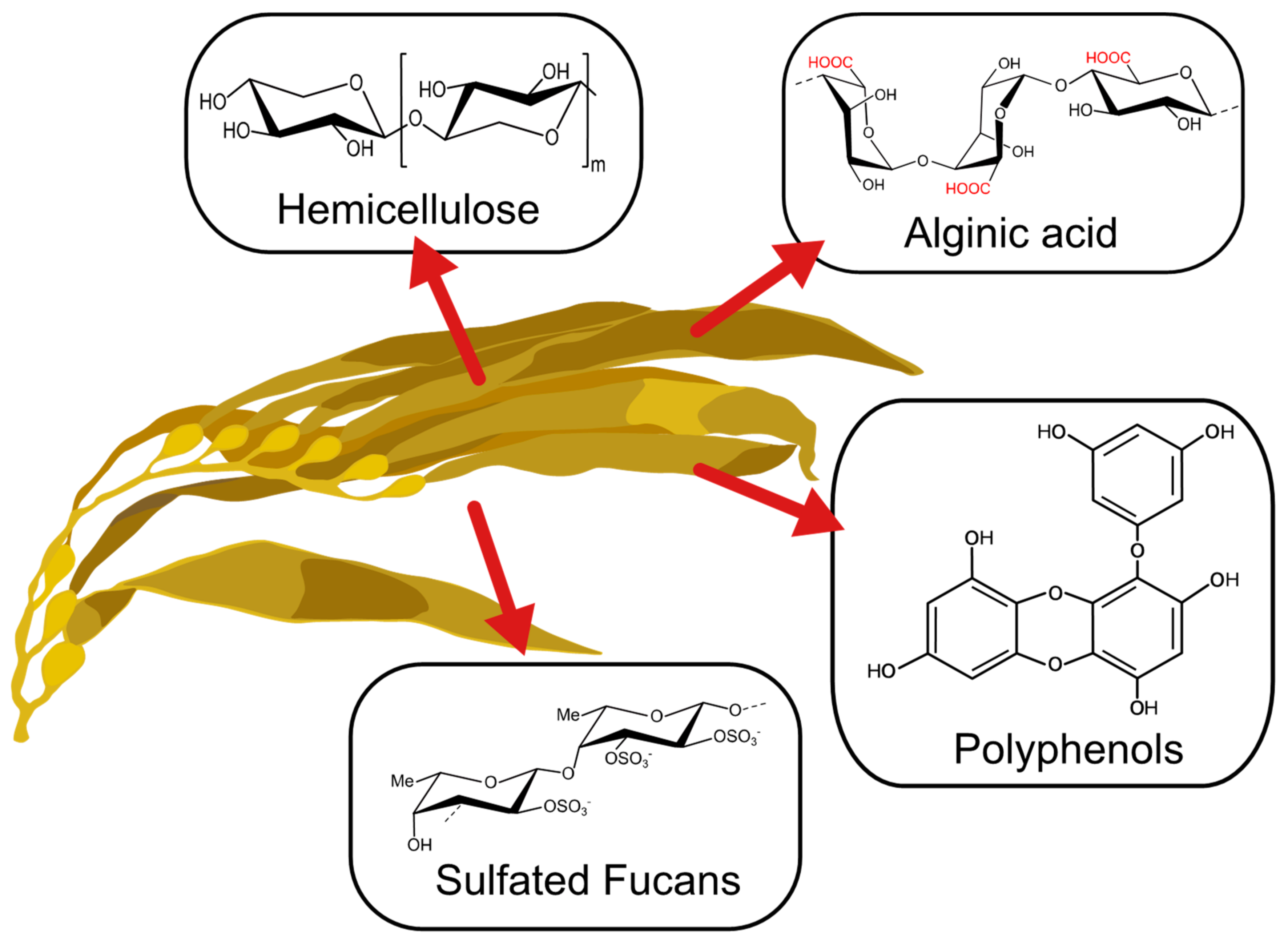
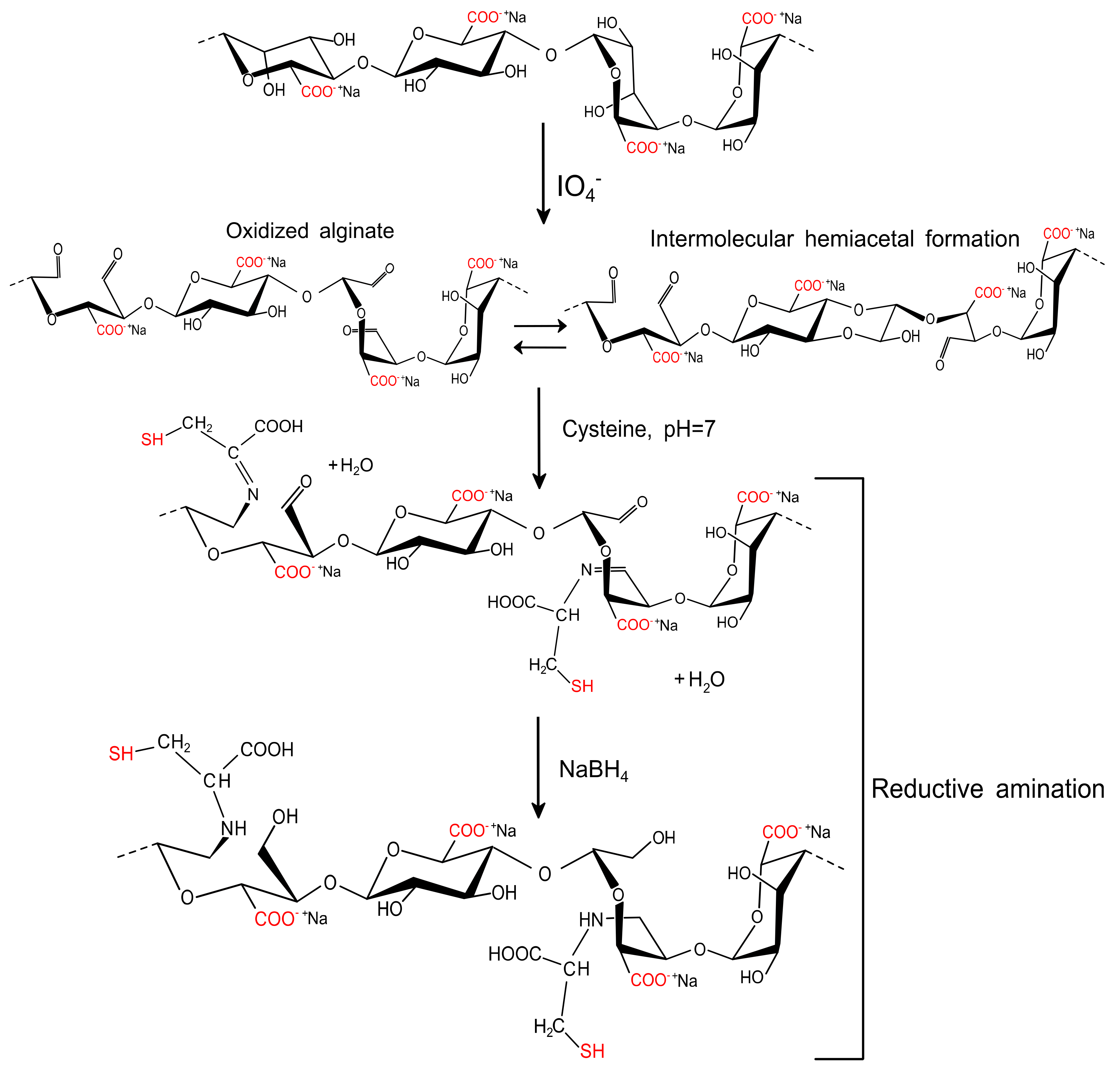
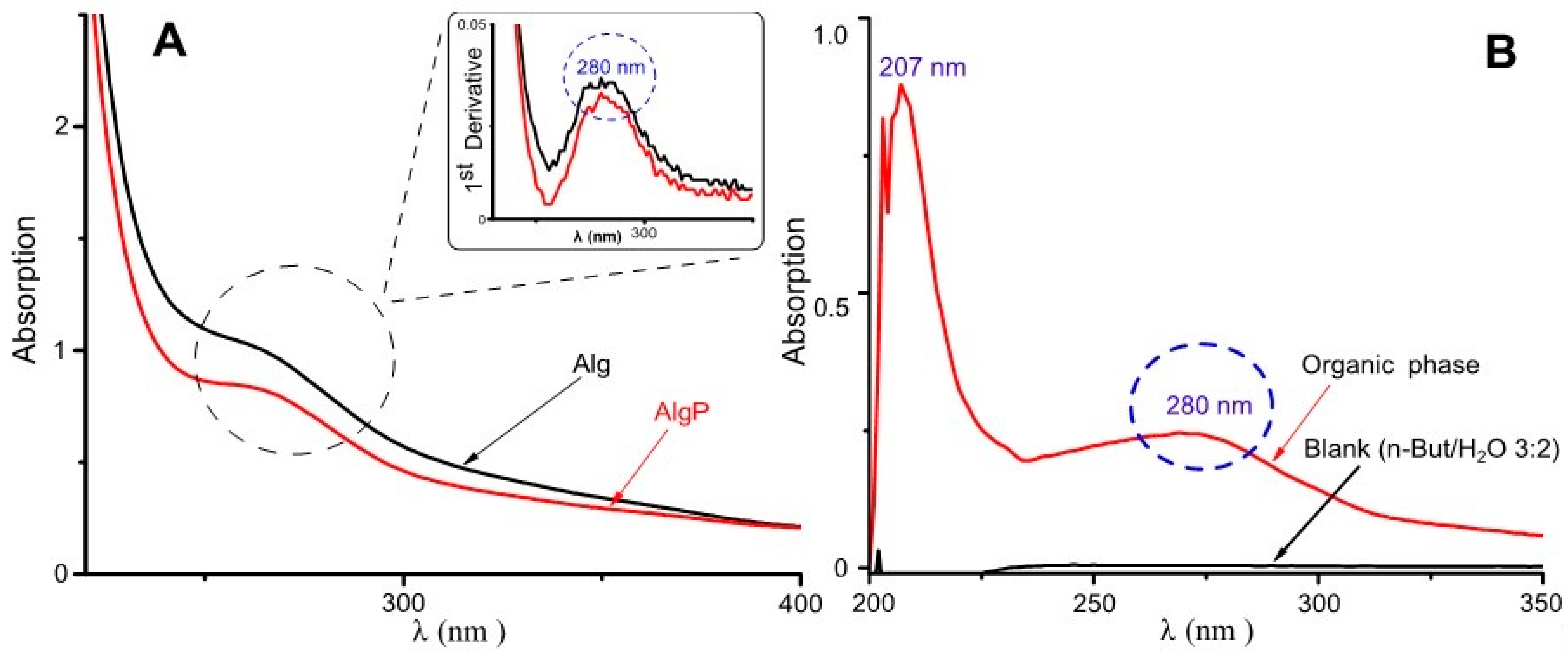
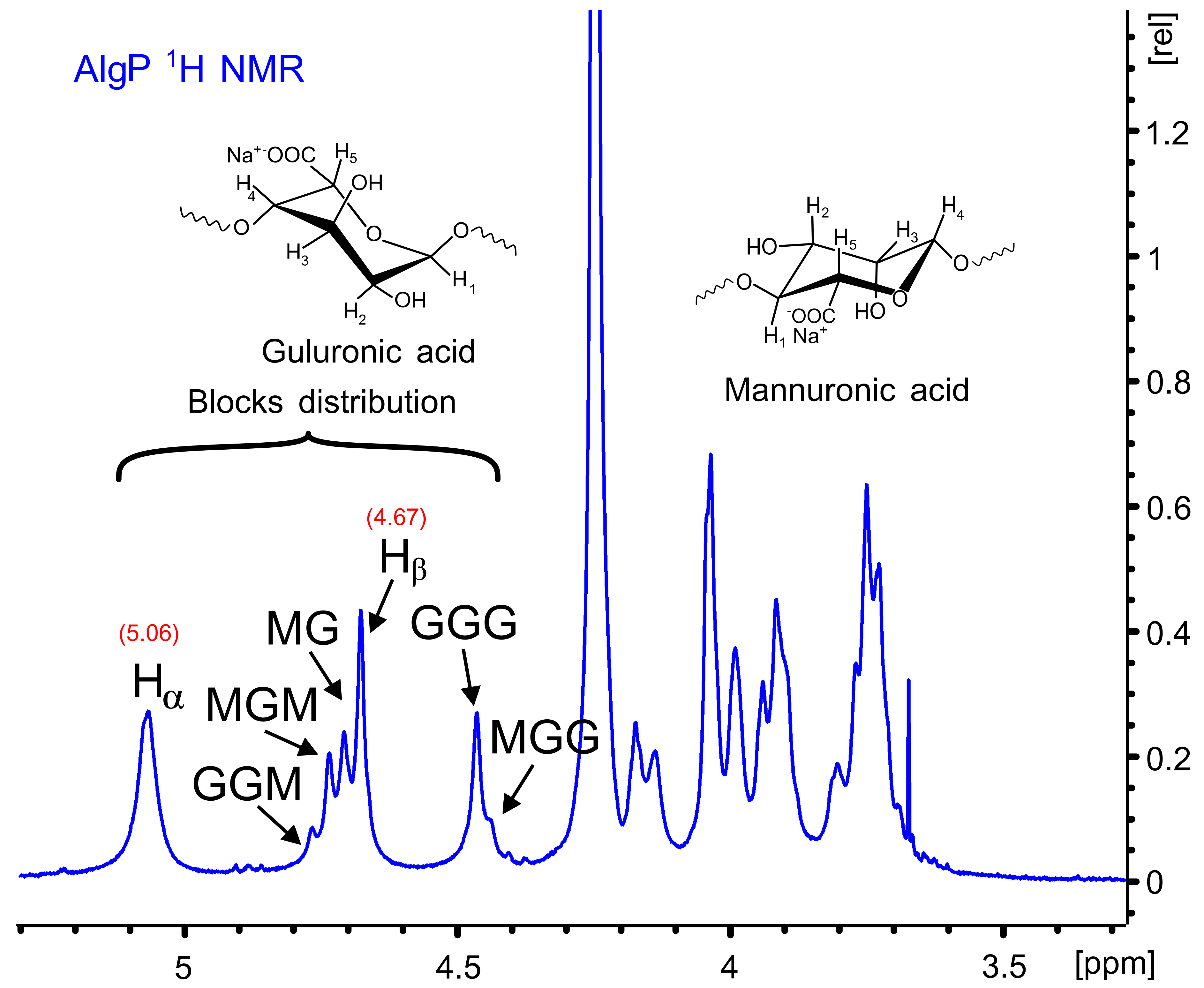

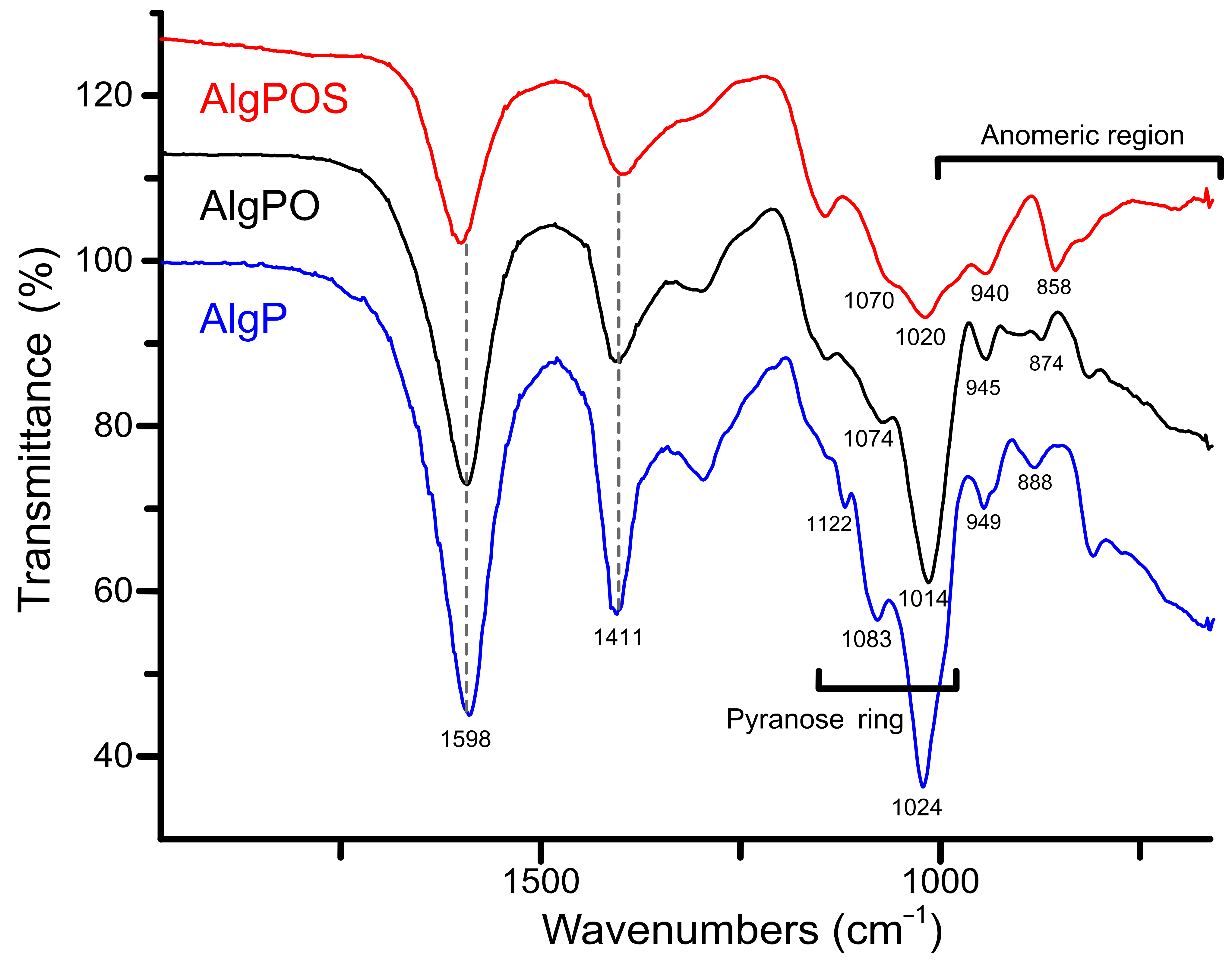

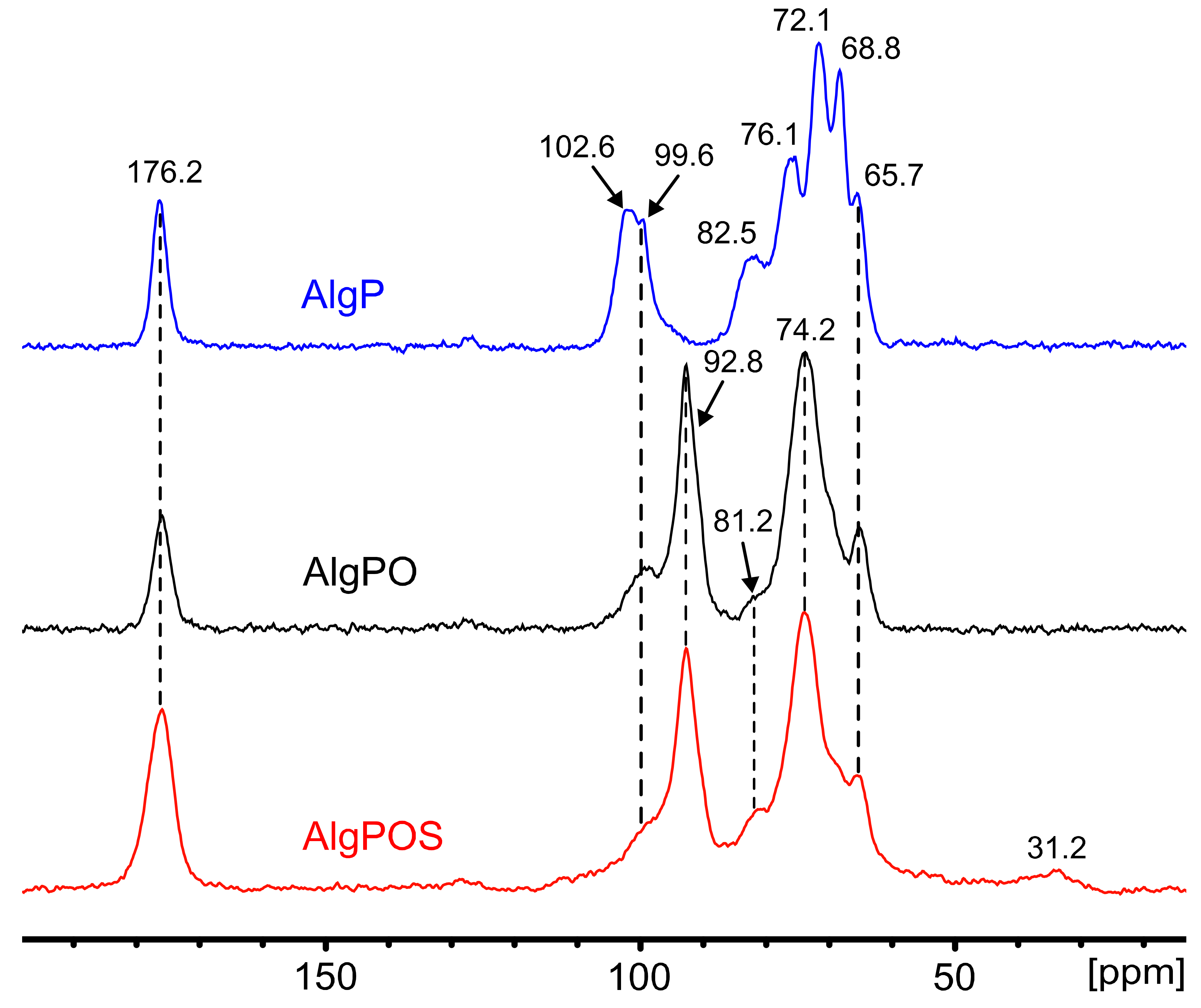
| Sample | δ (ppm) | ||||||||||
|---|---|---|---|---|---|---|---|---|---|---|---|
| H-1 | C-1 | H-2 | C-2 | H-3 | C-3 | H-4 | C-4 | H-5 | C-5 | C-6 | |
| AlgP a | 4.67 | 103.92 | 4.02 | 72.58 | 3.74 | 74.11 | 3.91 | 80.78 | 3.75 | 78.79 | 175.4 |
| AlgP b | 5.06 | 102.67 | 3.98 | 67.78 | 4.17 | 72.23 | 4.13 | 82.63 | 4.46 | 70.14 | 176.1 |
| δ (ppm) | ||||||||||||||
|---|---|---|---|---|---|---|---|---|---|---|---|---|---|---|
| Anomeric | Pyranose | Carboxylate | Hemiacetal | -CH2-SH | ||||||||||
| Assignment of M (mannuronic) or G (guluronic) carbons | G-1 | M-1 | G-4 | M-5 | M-4 | M-2 | M-3 | G-3 | G-5 | G-2 | M-6 | G-6 | ||
| AlgP | 102.6 | 99.6 | 82.5 | 76.1 | 72.1 | 68.8 | 65.7 | 176.2 | - | - | ||||
| AlgPO | - | 99.6 | 81.2 | 74.2 | - | 65.7 | 176.2 | 92.8 | - | |||||
| AlgPOS | - | 99.6 | 81.2 | 74.2 | - | 65.7 | 176.2 | 92.8 | 31.2 | |||||
Publisher’s Note: MDPI stays neutral with regard to jurisdictional claims in published maps and institutional affiliations. |
© 2021 by the authors. Licensee MDPI, Basel, Switzerland. This article is an open access article distributed under the terms and conditions of the Creative Commons Attribution (CC BY) license (http://creativecommons.org/licenses/by/4.0/).
Share and Cite
Huamani-Palomino, R.G.; Córdova, B.M.; Pichilingue L., E.R.; Venâncio, T.; Valderrama, A.C. Functionalization of an Alginate-Based Material by Oxidation and Reductive Amination. Polymers 2021, 13, 255. https://doi.org/10.3390/polym13020255
Huamani-Palomino RG, Córdova BM, Pichilingue L. ER, Venâncio T, Valderrama AC. Functionalization of an Alginate-Based Material by Oxidation and Reductive Amination. Polymers. 2021; 13(2):255. https://doi.org/10.3390/polym13020255
Chicago/Turabian StyleHuamani-Palomino, Ronny G., Bryan M. Córdova, Elvis Renzo Pichilingue L., Tiago Venâncio, and Ana C. Valderrama. 2021. "Functionalization of an Alginate-Based Material by Oxidation and Reductive Amination" Polymers 13, no. 2: 255. https://doi.org/10.3390/polym13020255
APA StyleHuamani-Palomino, R. G., Córdova, B. M., Pichilingue L., E. R., Venâncio, T., & Valderrama, A. C. (2021). Functionalization of an Alginate-Based Material by Oxidation and Reductive Amination. Polymers, 13(2), 255. https://doi.org/10.3390/polym13020255




